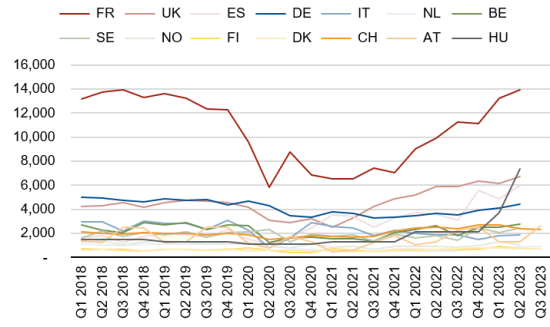Announcements
Drinks

Europe faces further rise in corporate defaults: insolvencies to plateau only late 2024, early 2025
Most pressure will fall on small businesses in those sectors most vulnerable to rising costs and tighter financial conditions, says Scope Ratings.
“Rising default rates are more than just a normalisation of the credit environment in Europe after the pandemic. They reflect substantially increased risks as higher-for-longer interest rates exacerbate pressures on corporate balance sheets in many sectors,” says Sebastian Zank, deputy head of corporate ratings at Scope.
Figure 1: Corporate stress: bankruptcy declarations rise; growth in new businesses falters
FY 2015 = 100 (seasonally adjusted)

Source: Eurostat, Scope
Corporate default rates have reached an interim peak…
Lagging monthly and quarterly data for major European economies already provides good evidence that the insolvency cycle has turned. Bankruptcy incidents for non-financial corporates have steadily risen for the past six consecutive quarters and H1 2023 data on corporate defaults stands at an all-time high in the EU since the data has been collected systematically in 2015. Available statistics for July and Aug 2023 also suggest that the rise of corporate default has not come to a halt in the third quarter.
… but present uneven picture across Europe
Second-quarter default numbers already largely exceeded pre-pandemic levels in major markets such as United Kingdom, Spain, Sweden, Finland, Switzerland and Hungary, while other markets such as Germany, the Netherlands, Italy and Norway are still way behind pre-Covid default statistics.
Growth rates in H1 2023 compared with same period the previous year are particularly high in France, Spain, Sweden, Norway and the Netherlands with YoY growth rates between 25% and 50%, and most strikingly in Hungary with an estimated YoY growth rate of more than 100%.
Figure 2: Quarterly number of business failures/defaults in major European countries
.png)
Source: Macrobond, Opten, Cerved, Scope
Companies with low interest cover in recent years now look vulnerable
“Firms with low interest coverage ratios, typically measured by EBITDA to interest coverage, will face financial stress or even distress now that interest rates on new capital market debt and bank loans have roughly doubled since mid-2022, affecting floating-rate debt and debt that needs to be refinanced.”
“We acknowledge that defaults are concentrated among small firms (often with fewer than 50 employees), but we expect the increased operational and (re)financing risk will spread to larger companies,” says Zank.
European firms face refinancing wall
European companies also have record levels of debt to be refinanced in the next three years. Firms will have to cover additional interest payments of around EUR 8.2bn in 2024 in refinancing maturing capital-market debt, having paid a similar amount in extra interest in refinancing bonds this year as rates have risen. The extra interest cost from durably higher borrowing rates will increase again in 2025 and 2026 as even more corporate debt comes up for refinancing.
Scope’s negative corporate rating actions rose sharply in first nine months of 2023
Rising defaults partly reflect catch-up from low levels of insolvency in 2020-2022 as governments supported business through the pandemic, but it is the increased macro-economic risks, including higher interest rates and the refinancing wall, which explain why default rates are likely to plateau only in H2 2024/H1 2025.
“Our corporate ratings activity suggests pressure on balance sheets and rising default risk is intensifying in some parts of the European economy,” says Zank.
Negative rating actions have almost doubled to 25% of the total in the first nine months of 2023 compared with the full-year average in 2021 and 2022. The share of positive rating actions has remained stable at around 15%. Given the sluggish economic outlook amid high interest rates, credit metrics, liquidity and profitability are unlikely to be maintained at a level commensurate with the old rating levels for a significant number of covered entities.
For further reading, see accompanying report: EU firms face growing interest-cost headache - Higher rates combine with bulge in maturing 2024-26 capital-market debt, published on 12 Oct 2023
Make sure you stay up to date with Scope’s ratings and research by signing up to our newsletters across credit, ESG and funds. Click here to register.






